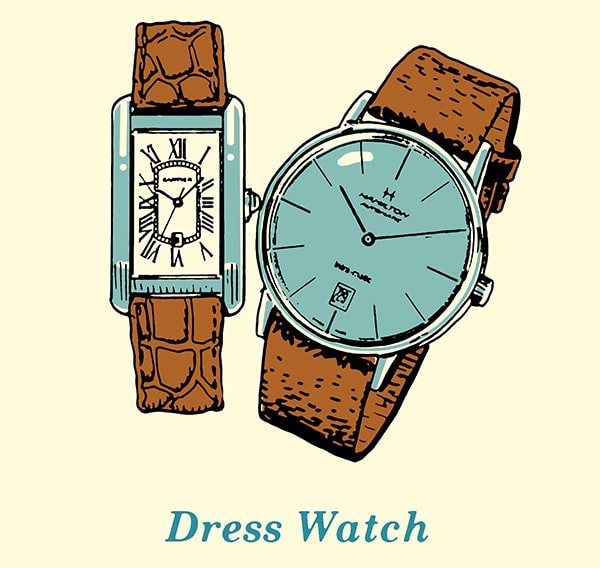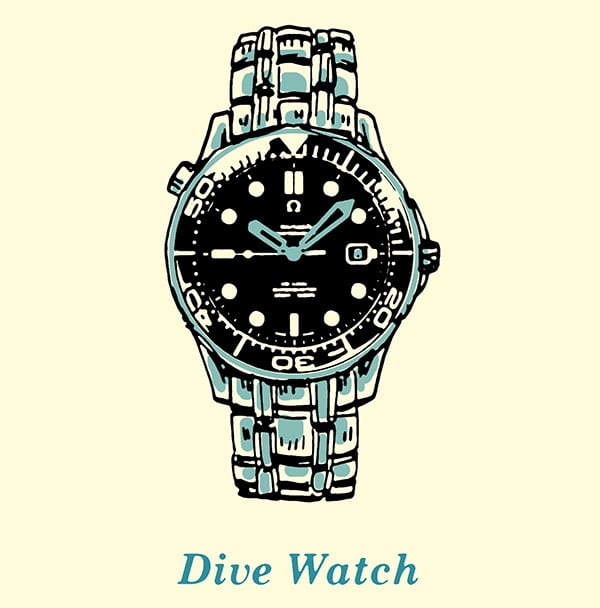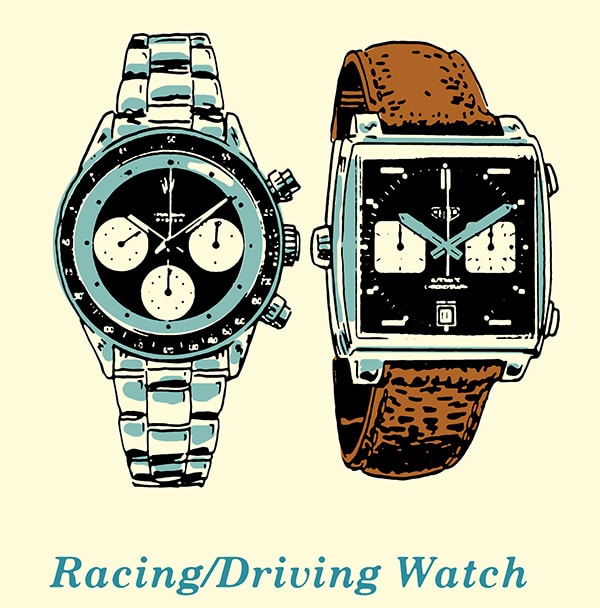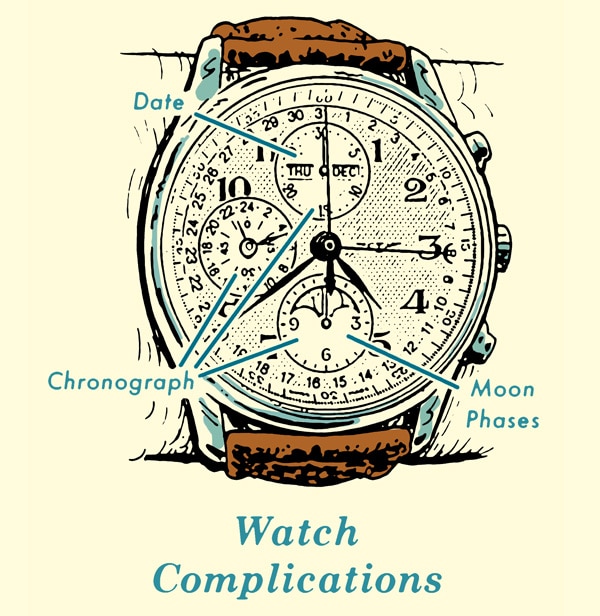
Last week we talked about the history of men’s wristwatches and why a man should still consider wearing one today.
If you’ve been looking to become a watch wearer yourself, or already are, but know almost nothing about the timepiece you tote around on your wrist, this article is for you. From weighing the pros and cons of different types of mechanisms, to offering dossiers on the various styles of men’s watches, we’ll cover the basics of everything you’ve always wanted to know about choosing and wearing this classic accessory.
Below you’ll find the ultimate guide to men’s wristwatches — all the essential information in one place, offered in an accessible, easy-to-understand way.
Watch Movements
When you start familiarizing yourself with watches, one word that’s going to come up a lot is “movement.” Movement encompasses not only the sweep of a watch’s hands around its face, but the way its inner mechanisms produce that effect. A watch’s movement is fundamental in how it works and keeps time — consider it the “heart” of the watch.
Watch movements come in three types: mechanical, automatic, and quartz. Below we explain the differences between them and their pros and cons.
Mechanical

A mechanical watch has a movement that’s powered by a mainspring — a coiled wire of metal — that is wound by hand. Once the mainspring is wound, it slowly and evenly unwinds, causing the second hand to move in a smooth, sweeping motion around the watch’s face. Most mainsprings are about 9-13 inches long. The longer the mainspring, the longer your mechanical watch’s power reserve, and the longer you can go between windings.
Not all mechanical movements are created equal. The attention to detail and craftsmanship that goes into a watch will determine its smoothness and accuracy.
For many aficionados, mechanical movement watches represent the crème de la crème of timepieces due to their traditional pedigree and the intricate work and engineering that must go into creating them. For these enthusiasts, owning a mechanical watch isn’t just about telling time, it’s a way to express their appreciation for history, refinement, and craftsmanship.
Pros of Mechanical Watches:
- No battery needed. Because a mechanical watch is powered by a hand-wound mainspring, you’ll never have to go to a jeweler to replace a battery. When the watch stops ticking, just wind it up.
- Smooth hand movement. For some folks, a smooth sweeping movement on the second hand is more aesthetically pleasing than the “tick tick tick” of quartz watches. If that’s important to you, go with a mechanical watch.
- Character. The engineering and work that goes into a mechanical watch is breathtaking. Inside your watchcase are tiny gears and springs that work together to give you the time. Sure, no one usually sees it, but that’s part of the charm; a watchmaker has spent hours and hours perfecting a mechanism that’s hidden from the eye. If you appreciate craftsmanship, then consider adding a mechanical movement watch to your collection.
- Tactile. For some, one of the appeals of a mechanical watch is that the owner must hand-wind it to keep it working. There’s something about the ritual of winding your watch at the end of the day that connects you more with time. There’s also something to be said for having to regularly tend to one of your possessions to keep it “alive” and ticking.
Cons of Mechanical Watches:
- Requires regular winding. While most mechanical watch mainsprings can go two days without winding, it’s recommended that you wind it once a day. As mentioned above, some folks get pleasure from this, but others find it a nuisance.
- Sensitive to the environment. Because a mechanical watch keeps time thanks to a bevy of intricate springs and gears, its movement can be highly susceptible to the environment. Moisture, dust, shocks, and magnets are the Four Horsemen of the Mechanical Watch Apocalypse. Thankfully, most modern varieties have been designed to withstand these elements, but care should still be taken. If you’re in an environment that puts you in frequent contact with moisture, dirt, magnets, and/or big bumps (like hammering or splitting wood), choose a quartz watch for daily wear and save the mechanical watch for dressier occasions.
- Not as accurate. While a well-crafted mechanical watch can keep time to 99.999% accuracy (which is about +/- 1 second a day), with age and use that accuracy starts to taper off. You’ll need to take your mechanical watch into a jeweler every 5 to 10 years for a tune-up to maintain its accuracy. What’s more, not all mechanical watches are created equal; some are more accurate than others. Finally, as mentioned above, environmental factors can deteriorate a mechanical watch’s accuracy. If strictly accurate timekeeping is your top priority, then you’ll want to opt for a quartz watch.
- Expensive. All that craftsmanship and precision engineering that goes into a mechanical watch is going to cost you extra. While there are some good mechanical watches in the sub-$500 range, most are more than that — often quite a lot more.
Automatic
Automatic watches are pretty much just like mechanical — they’re powered by a mainspring and use intricate gears to move the watch hands — but they don’t require the user to hand-wind the watch to keep it ticking. Instead, your movement throughout the day winds up the mainspring while you wear the watch. Hence, the name “automatic movement.” They’re also known as “self-winding” watches.
How does an automatic movement watch self-wind? Well, there’s a small weight inside the watch called a “rotor” that moves as your wrist moves throughout the day. It’s connected to the mainspring and winds the mainspring as it moves. Automatic watches also have a slipping clutch device to prevent the watch from getting over-wound while you’re wearing it.
If you’re not wearing your automatic watch, you’ll want to put it in a watch winder. It’s a little device that moves the watch in a circular motion while it’s stored so it stays wound. This is particularly important to do if your watch has features like a calendar or date display. For example, let’s say your automatic watch has a calendar on it, but you decide not to wear it for a few days. If you don’t store it in a winder, the power will run down and the display will get stuck on the time and date the watch stopped ticking. When you decide to wear the watch again, you’ll have to reset both.
Pros of Automatic Watches
- No battery needed.
- Don’t have to wind it by hand. If having to hand-wind a mechanical watch bothers you, but you still want the sophistication of a mechanical watch, an automatic watch is a nice compromise.
- Smooth movement. Just like manually-wound mechanical watches, automatic watches have a nice, smooth hand movement.
- Character. The same amount of engineering and craftsmanship goes into an automatic watch as a mechanical watch.
Cons of Automatic Watches
- Sensitive to the environment. The same environmental factors that can foil a mechanical watch can gum up an automatic watch.
- Needs to be stored in a watch winder when not in use. While an automatic watch doesn’t require winding if you wear it regularly, if you don’t, you’ll need to store it in a watch winder. Winders are relatively inexpensive and they don’t take up too much shelf space, but it’s one extra thing you have to buy in order to own an automatic watch.
- Less accurate. A well-crafted automatic watch can be as accurate as a well-crafted mechanical watch, but it will lose some accuracy over time and need tune-ups.
- Expensive. Same issue as mechanical watches. Craftsmanship and engineering ain’t cheap!
Quartz
If you’re like most average Joes, the watch on your wrist right now is probably a quartz watch. There’s a reason for that. Quartz watches are incredibly accurate and very affordable.
Instead of being powered by a wound mainspring, a quartz movement uses electricity from a small battery. The battery sends the electricity through a small quartz crystal, causing the crystal to vibrate 32,768 times per second. The vibrations are measured by a circuit, which converts the vibration into a pulse, which moves the second hand on the watch. Because quartz watches use electric pulses to move the second hand, they have a distinctive “tick tick tick” movement. It’s not as smooth as a mechanical or automatic watch.
Because quartz movements rely on electricity and fewer moving parts, they’re much more accurate and can withstand far more of a beating than mechanical or automatic watches. It’s for this reason that most “sport” and “field” watches use a quartz movement.
Quartz movements are also dirt-cheap. $4 can get you a watch that keeps time like a champ. Of course, if you want something with a bit more panache, you’ll need to spend more.
Pros of Quartz Watches:
- Accurate time. Quartz is by far the most accurate of all the movements. Will never lose or add seconds throughout the day.
- Less maintenance. Besides changing the battery every year or so, there’s little maintenance you have to perform on a quartz movement watch.
- Durable. Because they have few moving parts, a quartz watch can “take a licking and keep on ticking.” It’s not as susceptible to the Four Horsemen of the Watch Apocalypse. If you’re in a job that requires a lot of rough and dirty work, you might want to consider a quartz movement watch for everyday wear.
- Affordable. You can get quartz watches for as cheap as a few bucks. Though nicer looking ones can cost into the hundreds of dollars, they’re almost always cheaper than mechanical and automatic varieties.
Cons of Quartz Watches:
- No smooth movement. The staggered movement of the second hand on a quartz watch isn’t as smooth as that of a mechanical or automatic watch.
- Less romantic. The biggest con of quartz watches is that they lack the charm, character, and romance of mechanical watches because they lack the history, technical craftsmanship, and engineering such timepieces possess.
Watch Complications
Your basic wristwatch tells you the time.
But many wristwatches come with features that also display the date or even the phase of the moon. These little extras on wristwatches are called “complications.”
Besides calendars or moon phases, other complications include alarms, power reserve indicators, and repeaters (a feature that chimes the hour and minutes on your watch at the press of a button).
Then there’s the chronograph.
The chronograph is a separate and independent time system which serves as a stopwatch. Most chronographs consist of three small dials (also called sub-registers) within the main dial of the watch. On the side of the watch’s case, you’ll usually find two buttons: the top button starts/stops the chronograph, while the bottom button resets it.
On some watches, a chronograph is paired with a tachymeter — a scale inscribed around the rim of a watch. Using the chronograph and tachymeter together allows a user to calculate all sorts of things like speed, distance traveled, or fuel consumption (when you’re driving or flying).
(Chronographs and tachymeters are pretty dang cool and I plan on devoting an entire article on how to use them down the line. Stay tuned.)
How many and which complications you want in a watch is a matter of preference. Dressier watches tend to be sleek and have one (usually the date) to none. More sporty and casual watches often include more complications.
Men’s Watch Style Dossiers
While there are a plethora of functional men’s wristwatches out there from rubber sport watches you’d wear while running a 5K to tactical digital watches with a bunch of wiz-bang features, we’re going to focus on wristwatches you’d wear to class up an outfit. Sure, functional watches serve a purpose in a man’s life, but they just don’t look that great with a suit or at the office.
When it comes to stylish men’s wristwatches, there are basically five types: dress, field, diver, aviator, and racing. We’ve compiled dossiers on each one.
Dress Watch

History/Pedigree/Personality: Birthed in the early 20th century for well-to-do gentlemen who wanted to start wearing their timepiece on their wrist, rather than in their pocket. The dress watch is all about simplicity and sophistication; it’s sleek rather than encumbered. It’s not flashy, and draws attention to itself in a subtle way — for its classiness and how it compliments your get-up.
Signature Features:
- Size: Typically thin (to make it easy to slip in and out of a dress shirt cuff).
- Case: May be circular, rectangular, or square. High-end varieties are typically made from precious metals like gold or silver.
- Face: Dial displays simple hour indexes (the numbers, or symbols for numbers on the watch face) such as saber-style indexes (those little lines), Roman numerals, or small Arabic numerals.
- Band: Always leather. Though some companies offer both leather and metal band options with their dress watches, leather is the classic way to go.
- Complications: Little to none. At the most, a date and/or moon display.
When to Wear: As the name implies, you wear a dress watch for dressier, more formal occasions like with a business suit or a tuxedo (though, there’s debate as to whether you should ever wear a watch at all with black tie). But you can also wear a dress watch with everything on down to sharp casual. It won’t pair well with a t-shirt and jeans.
Examples:
Field Watch

History/Pedigree/Personality: The field watch is the descendant of the WWI “trench watch,” which was designed for officers who needed to coordinate attacks, tell time at night, and sport a wristwatch that could withstand the rigors of battle, all while still looking good. Field watches continue to evince a military-esque vibe and are rugged, functional, and stylish all at the same time.
Signature Features:
- Size: Small to medium. Large watches would just get in the way while you’re doing battle in the trenches of war, or business.
- Face: Functional, easy-to-read numerical indexes — typically a white dial and black numbering, or a black dial with white numbering. The hands on field watches often illuminate to enable time checks at night.
- Case: Typically stainless steel or sometimes titanium (they’re supposed to be rugged, after all!). Field watches sometimes include a feature called “hacking seconds” where you can stop the second hand by pulling the crown out; this makes it easier to set the watch to a reference signal, or synchronize it with another.
- Band: Leather or canvas strap. Metal is too heavy and would easily scratch with the kind of regular, rough and tumble use a field watch is designed for.
- Complications: Typically none, or date only.
When to Wear: Field watches are quite versatile and can be worn on all kinds of adventures as well as for everyday casual wear or even business casual. So everything from jeans and a t-shirt, to a sports coat and khakis. For men, especially younger guys, who don’t get dressed up in a suit very often, a field watch is probably your best bet; its simple, rugged style may best match your personality and lifestyle.
Examples:
Dive Watch

History/Pedigree/Personality: Next to the field watch, the dive watch is probably one of the most common watch types you see men sporting. And we likely have James Bond to thank for that. Ever since Dr. No, 007 has been sporting a dive watch of some kind or another. In the early Bond films, it was a Rolex Submariner (which is why the dive watch is sometimes called a “submariner”); then Pierce Brosnan turned the Omega dive watch into Bond’s timepiece of choice.
As the name suggests, the dive watch was designed for individuals who spend a lot of time in or near water. Their primary selling point is that they’re water resistant. The first iteration of what became the dive watch was likely the Rolex Oyster, which was introduced in the 1930s. With its hermetically sealed case, it was one of the first water resistant watches on the market.
In the 1950s, Rolex board member René-Paul Jeanneret wanted a watch that would be useful for when he went diving (a hobby he actively pursued) but still looked good as an everyday time piece. The Rolex Submariner was born and the standard for dive watches everywhere was set. Most dive watches on the market today take their design cues from the Submariner.
Signature Features: A dive watch is first and foremost water resistant. The standard for a dive watch is to be water resistant up to at least 100m, though some keep ticking at even lower depths.
Since it’s designed to be worn in the water, both the case and the band of dive watches are made from corrosion-resistant metals like stainless steel or titanium. (You’ll of course see dive watches made from rubber and silicone, too. They’re just not as classy looking.)
- Size: Medium.
- Face: Typically bold, easy-to-read, Arabic numbering, though the 12-hour numerals are often replaced with hash marks, with the seconds displayed in 15-second increments. To protect the watch face while deep underwater, sapphire or hardened mineral glass is used.
- Case: A defining feature of the dive watch is the uni-directional bezel included on the case — it will only rotate counter-clockwise. The rotating bezel allows a diver to know with just a glance at his watch how long he’s been underwater. Here’s how it works: when the diver enters the water, he rotates the bezel so that the “0” lines up with the minute hand. After that, the minute hand will point to the marking on the bezel that shows how long he’s been in the water.
- Band: Metal, and usually longer than other watches’ bands, as it was originally designed to fit around bulky dive equipment.
- Complications: Typically date only.
When to Wear: While the dive watch was designed for underwater use, its all-metal casing and band, plus its iconic heritage, make it a suitable wristwatch for versatile everyday wear. You can don it with your sports wear, casual wear, business causal wear, and business formal wear. And if you take your style cues from James Bond, you can even get away with wearing a dive watch with a tux.
Examples:
- Seiko Diver’s Watch
- Citizen Promaster
- Steinhart Ocean One
Pilot Watch

History/Pedigree/Personality: Wristwatches have been a part of aviation since its inception. In fact, one of the first purpose-specific men’s wristwatches ever made was for a pilot friend of Louis Cartier back in 1904 (the iconic Santos watch).
In the decades after, watchmakers built on that original design to make timekeeping easy for pilots taking off into the wild blue yonder, most notably with the addition of a chronograph. Back in the 1930s, the Swiss company Breitling made onboard chronographs for planes in the Royal Air Force so pilots could determine their speed, distance traveled, and fuel consumption. In the 1940s, they decided to put their chronograph on a wristwatch — creating the Breitling Chronomat, as well as the mold for future aviator watches.
Signature Features: Unlike other men’s watch styles, the pilot watch doesn’t have a firm, distinctive style; the features of timepieces marketed as “aviator watches” can widely vary. That being said, the following are the features that are most common to this type of watch:
- Size: Medium to large.
- Face: Designed for easy reading, even in a dark cockpit, pilot watches sport an oversized dial with clean, legible numbers and luminous hands. To make reading the time even easier, the dial is usually black with white numbering.
- Band: Often, though not always, made of leather. Longer than average, as the band was originally designed to fit around the cuff of a pilot’s flight jacket.
- Complications: Date and sometimes a chronograph.
When to Wear: The size and more casual look of pilot watches make them a good fit for more casual get-ups, but not for black tie and formal business wear.
Examples:
Racing (or Driving) Watch

History/Pedigree/Personality: Car racing and wristwatches have been linked together since the 1930s. That’s because racecar driving relies on accurate timekeeping to measure the outcome of the race. Rolex was one of the first companies to capitalize on this need for accurate timepieces by outfitting top drivers with their famous Oyster watch back in the 1930s.
But it was TAG Heuer that created the standard for racing watches by adding a chronograph and tachymeter — the two defining features of a driving watch. The first TAG Heuer chronographs were made in the 1930s and 1940s for pilots in the Luftwaffe, but by the 1950s and 1960s, racecar drivers were wearing them to measure their speed and distance. TAG Heuer cemented its racing bona fides when actor Steve McQueen wore their Monaco 1133 in the 1971 film, Le Mans.
Signature Features:
- Size: Medium to large.
- Face: Large dial (to make room for the chronograph), with clear Arabic numerals. Often includes bright, contrasting colors.
- Case: Designed to withstand the rigors of auto racing, the case is typically made from stainless steel.
- Band: Leather or metal.
- Complications: Chronograph and sometimes the date.
When to Wear: Racing watches tend to be flashier looking than dive or pilot watches. Because of their bold look, they’re more suitable for casual than formal wear.
Examples:
- TAG Heuer Carrera Calibre 18
- TAG Heuer Monaco 1133
- Timex Intelligent Quartz Fly-Back Chronograph
- Seiko Sportura
Picking the Perfect Watch For Your Hand Size
One of the factors to consider in choosing a watch is how well proportioned the watch is to your wrist and hand. If it’s too big for your wrist, it will stand out and look garish; too small and it will look like you’re wearing a lady’s timepiece.
The general rule is if the circumference of your wrist is 6 to 7 inches, you want to go with a watch that has a case diameter of 38-42 mm wide. If your wrist is larger than 7 inches, then you can go with cases that are 44-46 mm wide.
The best way to figure out if a watch is proportional to your wrist and hand is to try it on and eyeball it. Ask friends and family for their opinion.
Of course, watches are statement pieces. So if you want to go with the giant, rap-mogul watch, go right ahead. Just understand that by doing so, you’re communicating to the world that conspicuous consumption is important to you.
Are Expensive Watches Worth Buying?
Once you decide what type and style of watch you want, you’ll next need to decide what kind of price range to look in.
When you see the $8,000 price tag on a Rolex Submariner or that a TAG Heuer Carrera goes for $4,500, you might ask yourself “Are these watches really worth that much if they tell time just as well as my $10 Casio?”
Well, that’s a complicated question to answer and it somewhat depends on what sort of luxury watch we’re talking about: mass market luxury watches or luxury luxury watches.
One criticism levied at mass-market luxury watches is that the high price is simply the result of clever marketing. Rolex and TAG Heuer can charge thousands of dollars for a watch not due to scarcity (these companies mass-produce their iconic watches by the hundreds of thousands each year), but because they’ve created the perception in the public through decades of advertising that their watches are rare and worth thousands of dollars. It’s the same criticism levied at diamond makers. Diamonds, in reality, are plentiful. Diamond producers have made them a sought-after luxury item through decades of marketing them as such.
While it’s true that the high prices of mass-produced luxury watches are partly due to branding, there are factors in the watch itself that make it worth more than your $200 watch from the department store. For starters, these luxury watches are often made with fine metals like gold and silver. Given the price of gold these days, a gold Rolex is going to be expensive any way you slice it. They also use a higher quality glass or even sapphire to cover the watch face.
What’s more, the technology and thought that went into designing a mass-produced luxury watch is typically far superior to the technology and thought that went into making a $200 department store watch. In short, they’re made better, work better, and last longer.
So with mass-market luxury watches, you’re definitely getting a superior watch in terms of its build and movement compared to other watches, but you’re also paying for the mystique, story, and social cache that come with a brand name. It’s up to you to decide if that’s important when buying a watch.
That leads us to luxury luxury watches. These are watches that can cost tens of thousands and sometimes hundreds of thousands of dollars. Companies like Audemars Piguet, Blancpain, and IWC exist in this realm. These watches can command these sorts of prices because they’re actually scarce. Oftentimes, just a few hundred or maybe a thousand of a particular watch are made. And this isn’t some artificial scarcity. They’re often meticulously handcrafted (with the help of machines of course) from the finest materials. Some of the watches from these companies take months or even years to be finished. So, yeah, with these types of luxury watches, you’re definitely getting what you pay for: high-end craftsmanship.
Luxury watches are thus a lot like luxury cars. There is a difference in the quality, features, and engineering of a high-end vehicle, but you’re also paying for the brand, for the status symbol. Some folks are attracted to luxury cars, and to luxury watches, for both reasons, and they feel that the enjoyment they get out of the possession warrants the steep price tag.
For other folks, buying a luxury car, or watch, will never cross their mind. It’s not in their price range, and even if it was, they’ve got other things they can spend that money on, and luxury watches offend their sense of republican virtue — their commitment to frugality and modesty (I’m admittedly in this camp).
That being said, “frugality” is of course an entirely relative trait, which depends on one’s personal income (Jefferson and Washington didn’t live in mud huts and walk around in burlap sacks, after all). If a billionaire wants to buy a $10,000 watch, that doesn’t make him a spendthrift; it’s just a drop in the bucket for him.
For the rest of us average Joes, invest in the best quality watch that fits your needs, desires, and budget. There are plenty of nice-looking watches that don’t cost an arm and a leg. My own go-to watch is the Spirit of St. Louis (a pilot watch), which comes in at a reasonable $225, and I still get lots of compliments on it. If you want something a little outside your current budget, ask for a nice watch as a gift; timepieces make great birthday, Christmas, and graduation presents.
Well, there you go. A guide to the world of horology. While we got pretty comprehensive in this article, we only scratched the surface on wristwatches. If this topic interests you, I highly recommend checking out sites dedicated to all things wristwatches. A few of my favorites include Worn and Wound, Hodinkee, and A Blog to Watch. Gear Patrol also does some bang-up write-ups on watches.
Tags: Watches








